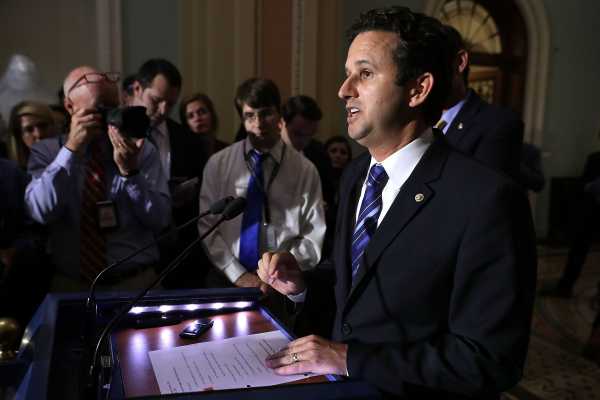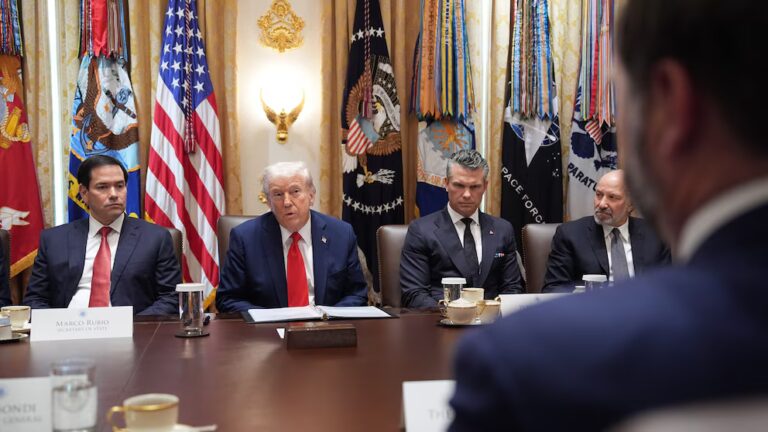
Sen. Brian Schatz (D-HI) is tired of hearing about making college more affordable. He wants to get it done.
“I don’t want to go back to every college campus eight years after my first election and say the same stuff,” Schatz told me as we sat in his Senate office recently. “Whether I can stomach, morally, just talking about college affordability for eight years, or 14 years, or 20 years … shame on all of us for running on this without fixing it.”
Schatz, the senior senator from Hawaii, will introduce a plan on Thursday that’s essentially Hillary Clinton’s and Bernie Sanders’s college affordability plans on steroids. Schatz’s bill, called the Debt Free College Act of 2018, aims for debt-free rather than tuition-free college (as Sanders offered). It also expands the no-debt promise from just tuition (as in Clinton’s plan) to include living expenses as well.
Debt-free college plans like Schatz’s take the full cost of college into account, including living expenses, meal plans, and books. In these plans, help is often given through need-based grants to low-income students and families, while those who can afford the extra costs will still have to pay them.
In contrast, Sanders’s tuition-free plan would have made tuition free for everyone regardless of family income, but living expenses would not be covered.
Those extra costs add up. As Schatz estimates, the average annual cost of tuition at state schools is about $8,900. But the total annual cost of college including tuition, housing, food, and books is closer to $20,000.
“Covering tuition for everybody is not a bad idea — it’s just that tuition is only 45 percent of the cost of college,” Schatz said. “And I also believe that we ought to cover the full cost of college for people who can’t afford it before we cover tuition for people who can.”
The plan, which already has eight Senate Democrats and 14 House Democrats co-sponsoring, would set up a new voluntary partnership between states and the federal government with the goal of alleviating debt for students at two- and four-year public universities.
Participating states would get a dollar-for-dollar match from the federal government for however much funding they appropriate for state schools. In exchange, those schools would have to commit to helping students pay for the full cost of college without taking on debt, through need-based grants to help students who can’t afford it cover costs.
It also comes with a hefty price tag: $80.1 billion for the first year of federal-state partnership and $95.4 billion to meet the goal of debt-free college for all students.
Tiffany Jones, director of higher education policy at the nonprofit Education Trust, said Schatz’s plan is one of the first to address the comprehensive cost of college, including the cost of housing, transportation, and other expenses.
“Much of the free college discussion has been making it tuition-free,” Jones said. “The idea of making it debt-free is about making it affordable for low-income students first. I think this piece of legislation goes in a helpful direction.”
The problem Schatz is trying to fix: states aren’t spending as much on higher education as they used to
The problem of rising student debt at public colleges can be traced back to the early and mid-2000s. States picking up less of the cost of providing education at their public schools is a trend that started before the Great Recession, but it was dramatically exacerbated by the 2008 economic crisis.
In the wake of the recession, states tightened their budgets and cut money for public colleges. But even as the economy has improved since 2008, the picture of costs and student debt is still grim.
To give you a sense of where things stand, in the 2017 school year, overall state funding for public two- and four-year colleges was nearly $9 billion below the 2008 level (after adjusting for inflation), according to the Center on Budget and Policy Priorities, a left-leaning think tank.
As Vox’s Libby Nelson wrote in 2016:
There are staggering statistics about America’s collective student debt: It now exceeds $1.4 trillion, is second only to US mortgage debt, and has surpassed credit card debt.
Sarah Raskin used to think about this problem and how it impacted the US economy a lot when she was deputy secretary of the US Treasury under the Obama administration. An expert who examined the student loan crisis and its impact on the economy during the previous administration, she recently reviewed the Schatz plan.
Raskin, who now teaches a seminar called Law and Financial Anxiety at the University of Maryland’s Francis King Carey School of Law, now sees the issue from a much more personal level — through the eyes of her students. When Raskin asks her students what the concept of financial anxiety means to them, she estimates that 90 percent mention student debt as a pressing concern.
“There’s a real demand that this be an issue that gets addressed,” she said. “The political mandate for doing something in this area is really great.”
Still, the issue of debt and defaulting on loans is much more of a crisis for low-income students, particularly students of color. A recent Brookings Institution report found that student debt and loan default among black college students was far worse than among their white counterparts. Black graduates with a bachelor of arts degree default at five times the rate of whites with the same degree, 21 percent compared to 4 percent.
The Education Trust is specifically focused on issues of inequity in higher education, and Jones said something that is often forgotten in discussions of student loan debt is that low-income students and students of color — especially those who default on their loans — are much more impacted than middle-class students who are still able to pay off their loans.
“This is why the cost of living piece is so critical and tuition is not enough,” she said. “If anything, we don’t want folks disengaging on higher education. This still is the key to social mobility.”
For that reason, Jones and Raskin said they are glad to see Schatz put forth a big-picture idea to try to solve the problem, even as the issue has faded from public view.
“I really commend him for taking this on,” Raskin said. “It’s supporting the institutions that deserve support, which are our public institutions. Just to get something to emerge from all the noise is critical because we do need to move forward on this issue.”
After year one of the partnership, Schatz estimates that if all states joined the proposed partnership and maintained their current appropriation levels for public universities, 10 states would be able to go debt-free for public university students, 22 states could provide debt-free college for their Pell Grant recipients and a portion of non-Pell students, and 18 states could make debt-free college a reality for many Pell recipients.
Schatz knows both Democrats and Republicans recognize this as a problem, but he’s frustrated with the lack of action. He mentioned a recent Senate Banking Committee hearing with the new Republican chair of the Federal Reserve, Jerome Powell, in which Powell mentioned without prompting that college debt is non-dischargeable.
“He agreed with me that it was a national economic problem, both on the debt side but also what it does as a disincentive toward getting a higher education,” Schatz said.
The rise and fall of affordable college as a political issue
The issue of affordable college became a progressive rallying cry in 2016; Bernie Sanders’s success on the issue with college students in the Democratic primaries was one of the reasons Hillary Clinton introduced a tuition-free affordable college plan in the general election. The issue also came up, albeit less frequently, at Donald Trump campaign rallies in 2016.
After Trump was elected, the federal government has largely been silent on the issue. Under Education Secretary Betsy DeVos, Trump’s higher education policy actions have been relegated to quietly rolling back Obama-era regulation preventing predatory student lending practices.
Despite millions of students clamoring for cheaper college education, relief doesn’t appear to be coming anytime soon. Meanwhile, the cost of college keeps rising.
“One of the reasons I feel so strongly about this is that I think both parties have been running on this, and we haven’t done the hard legislative work,” Schatz told me. “And on a personal level, I prioritized this in my 2014 campaign, and I told my staff, ‘I don’t want to be coming back in 2022 running on college affordability again.’ Because then it’s just a device for getting votes.”
Solving the student loan crisis has historically been a bipartisan issue; for instance, Sen. Marco Rubio (R-FL) has talked a lot about how he was personally affected by his student loans and introduced legislation with Sen. Mark Warner (D-VA) to cap student loan payments and streamline the repayment process.
But overall, Schatz sees little appetite from his Republican colleagues to reform the system. And with hastily passed GOP tax cuts estimated to add $1 trillion to the national deficit over the next decade, Schatz said he’s not yet going to wade into details of how he’ll pay for his plan because he thinks there’s a double standard with Republicans and Democrats.
“I don’t play the pay-for game. I reject the pay-for game,” he said. “After the Republicans did the $1.5 trillion in unpaid-for tax cuts, and as we’re doing a bipartisan appropriations bill — which I support — which is also an increase in federal spending [that’s] unpaid for … I just reject the idea that only progressive ideas have to be paid for. We can work on that as we go through the process, but I think it’s a trap.”
And he’s under no impression that his bill will gain traction in the current Republican-controlled Congress, especially given the tumult of news swirling around President Donald Trump and few signs from Republicans that they’re going to seriously entertain the issue.
“One of the things I have observed among Republicans — and part of it is that they’re just unserious about governing in the first place, but I certainly observed on health care that they had no actual legislative program once they got the gavels,” Schatz said. “And I think it’s important for us to draw a clear contrast with Republicans over the rest of the year, but also be ready to govern.”
With the possibility that political winds could be shifting in 2018, Schatz wants to have a plan in place should Democrats regain the majority. He sees his plan as a starting point, not the be-all and end-all.
“Part of what I’m trying to do is prepare for the very real possibility that we will have gavels soon,” he said. “We’ve now, as a party, decided that we want kids to be able to afford college. And what I’m trying to do here is flesh out how we do that.”
Sourse: vox.com






